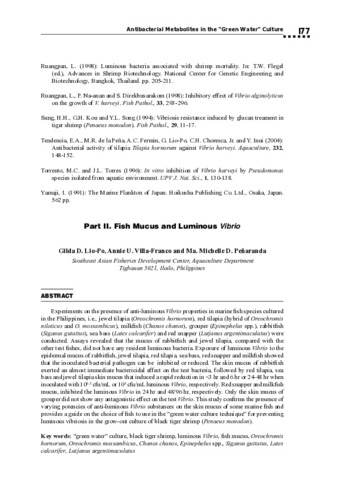Antibacterial metabolites in the microbial and phytoplankton flora of the "green water" culture of shrimp (Penaeus monodon): Part II. Fish mucus and luminous Vibrio
- Global styles
- MLA
- Vancouver
- Elsevier - Harvard
- APA
- Help

Date
2005-03Page views
2,712ASFA keyword
AGROVOC keyword
Taxonomic term
Metadata
Show full item recordShare
Abstract
Experiments on the presence of anti-luminous Vibrio properties in marine fish species cultured in the Philippines, i.e., jewel tilapia (Oreochromis hornorum), red tilapia (hybrid of Oreochromis niloticus and O. mossambicus), milkfish (Chanos chanos), grouper (Epinephelus spp.), rabbitfish (Siganus gutattus), sea bass (Lates calcarifer) and red snapper (Lutjanus argentimaculatus) were conducted. Assays revealed that the mucus of rabbitfish and jewel tilapia, compared with the other test fishes, did not have any resident luminous bacteria. Exposure of luminous Vibrio to the epidermal mucus of rabbitfish, jewel tilapia, red tilapia, sea bass, red snapper and milkfish showed that the inoculated bacterial pathogen can be inhibited or reduced. The skin mucus of rabbitfish exerted an almost immediate bactericidal effect on the test bacteria, followed by red tilapia, sea bass and jewel tilapia skin mucus that induced a rapid reduction in <3 hr and 6 hr or 24-48 hr when inoculated with 101-3 cfu/mL or 105 cfu/mL luminous Vibrio, respectively. Red snapper and milkfish mucus, inhibited the luminous Vibrio in 24 hr and 48/96 hr, respectively. Only the skin mucus of grouper did not show any antagonistic effect on the test Vibrio. This study confirms the presence of varying potencies of anti-luminous Vibrio substances on the skin mucus of some marine fish and provides a guide on the choice of fish to use in the “green water culture technique” for preventing luminous vibriosis in the grow-out culture of black tiger shrimp (Penaeus monodon).
Suggested Citation
Lio-Po, G. D., Villa-Franco, A. U., & Peñaranda, M. M. D. (2005). Antibacterial metabolites in the microbial and phytoplankton flora of the "green water" culture of shrimp (Penaeus monodon): Part II. Fish mucus and luminous Vibrio. In K. Nagasawa (Ed.), Recent Advances in Diagnosis and Prevention of Fish and Shrimp Diseases in Southeast Asia (pp. 177–182). Tigbauan, Iloilo, Philippines: Aquaculture Department, Southeast Asian Fisheries Development Center.
Type
Book chapterISBN
9718511732
Related items
Showing items related by title, author, creator and subject.
-
The Philippine aquaculture industry
Camacho, Arsenio S.; Macalincag-Lagua, Natividad (Aquaculture Department, Southeast Asian Fisheries Development Center, 1988)The aquaculture sector of the Philippine fishing industry registered the highest growth rate of 12.5% in 1977-1986. The contribution of aquaculture to the total fish production was equivalent to 24% in 1986 compared to ... -
Milkfish and shrimp fry grounds and seasons
Southeast Asian Fisheries Development Center, Aquaculture Department (Aquaculture Department, Southeast Asian Fisheries Development Center, 1988) -
Aquaculture in the Philippines
Aypa, Simeona M. (Aquaculture Department, Southeast Asian Fisheries Development Center, 1995)Aquaculture is regarded as the most promising source of protein food in the years ahead. Milkfish and Nile tilapia are the major fishes now produced but groupers, sea bass, rabbitfish, red snappers, carps, and catfishes ...

 AQD Access
AQD Access




